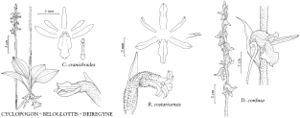Cyclopogon
Reliq. Haenk. 1: 93, plate 13. 1827.
| Taxon | Illustrator ⠉ | |
|---|---|---|
 | Cyclopogon cranichoides Beloglottis costaricensis Deiregyne confusa | Barbara Alongi Barbara Alongi Barbara Alongi |
Herbs, terrestrial, sympodial. Roots fasciculate, fleshy, villous. Stems simple, rhizomatous. Leaves few-to-many, basal, petiolate; blade not articulate, convolute, mostly ovate to elliptic, soft. Inflorescences terminal, many-flowered spikes or racemes, erect; scapes bracteate. Flowers resupinate, horizontal, greenish or yellowish green, small; sepals subparallel, distinct or connate at base, forming obscure mentum with base of column or sepaline nectar tube; petals connivent with dorsal sepal; lip clawed, sagittate to cordate, constricted proximal to apex; lateral margins appressed to sides of column; column erect; pollinia 2, clavate-oblong, mealy; stylar canal entrance central; stigma lobes 2, distinct or approximate; rostellum longer than wide; viscidium relatively large, disc-shaped; ovary sessile or subsessile. Fruits capsules.
Distribution
Tropical and subtropical regions, s North America, Mexico, West Indies, Central America, South America
Discussion
Species 70 (2 in the flora).
All species of Cyclopogon except the holotype were placed in the genus Beadlea (L. A. Garay 1980[1982]) because their perianth base was not united into a tube. That characteristic was rejected as a valid generic distinction but the taxon was recognized as Cyclopogon sect. Beadlea (P. Burns-Balogh 1982; P. Burns-Balogh and H. Robinson 1983). The perianth tube character is a matter of degree and not one of presence or absence (D. L. Szlachetko 1993).
Selected References
None.
Lower Taxa
Key
| 1 | Midvein and margins of petals darkened distally; lip broadest proximal to apical constriction; leaf blades purplish abaxially, dark purplish green adaxially; petioles spreading to suberect, 1.1–3.5(–5.5) cm. | Cyclopogon cranichoides |
| 1 | Midvein and margins of petals unmarked distally; lip broadest distal to apical constriction or distal and proximal parts of lip equal in width; leaf blades green; petioles erect, 3–10 cm. | Cyclopogon elatus |